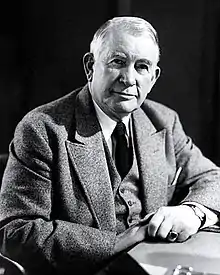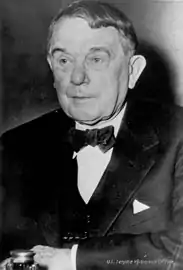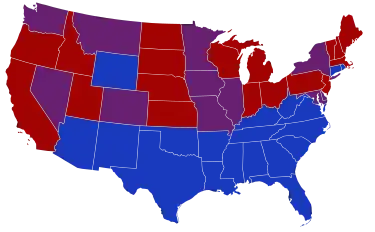82nd United States Congress
The 82nd United States Congress was a meeting of the legislative branch of the United States federal government, composed of the United States Senate and the United States House of Representatives. It met in Washington, D.C., from January 3, 1951, to January 3, 1953, during the last two years of President Harry S. Truman's second term in office.
| 82nd United States Congress | |
|---|---|
81st ← → 83rd | |
 United States Capitol (1956) | |
January 3, 1951 – January 3, 1953 | |
| Members | 96 senators 435 representatives 3 non-voting delegates |
| Senate majority | Democratic |
| Senate President | Alben W. Barkley (D) |
| House majority | Democratic |
| House Speaker | Sam Rayburn (D) |
| Sessions | |
| 1st: January 3, 1951 – October 20, 1951 2nd: January 8, 1952 – July 7, 1952 | |
The apportionment of seats in this House of Representatives was based on the 1940 United States census.
Both chambers had a Democratic majority (albeit reduced from the 81st Congress), and with President Truman, maintained an overall federal government trifecta.
Major events
- March 29, 1951: Ethel and Julius Rosenberg were convicted of conspiracy to commit espionage. On April 5 they were sentenced to receive the death penalty.
- April 11, 1951: President Truman relieved General Douglas MacArthur of his Far Eastern commands.
- April 13, 1951: Congress passed a large defense budget 372 votes for the budget and 44 votes against the budget. The budget was intended to help the United States combat communism.[1]
- August 31, 1951: The United States Senate passes the Mutual Security Act by a vote of 61 votes in favor and 5 votes against. The act provided $7.5 billion for foreign military assistance and food aid to America's allies, primarily the United Kingdom.[2][3] The vote was condemned by the government of the Soviet Union and praised by the government of the United Kingdom.[4]
- September 5, 1951: Treaty of San Francisco: In San Francisco, California, 48 nations signed a peace treaty with Japan to formally end the Pacific War.
- October 24, 1951: President Truman declared an official end to war with Germany.
- November 10, 1951: Direct dial coast-to-coast telephone service began in the United States.
- December 31, 1951: The Marshall Plan expired after distributing more than $13.3 billion USD in foreign aid to rebuild Europe.
- March 29, 1952: President Truman announced that he will not seek reelection.
- June 19, 1952: The Special Forces created.
- July 25, 1952: Puerto Rico became a Commonwealth of the United States, an unincorporated organized territory, with the ratification of its constitution.
- November 4, 1952: 1952 United States presidential election: Republican Dwight D. Eisenhower defeated Democrat Adlai Stevenson
- November 4, 1952: National Security Agency founded.
Major legislation
- October 10, 1951: Mutual Security Act, ch. 479, 65 Stat. 373
- June 27, 1952: Immigration and Nationality Act (McCarran-Walter Act), Pub. L.Tooltip Public Law (United States) 82–414
- July 14, 1952: McGuire Act, Pub. L.Tooltip Public Law (United States) 82–542, 15 U.S.C. § 42(a)
- July 16, 1952: Veterans' Readjustment Assistance Act, Pub. L.Tooltip Public Law (United States) 82–550
- July 16, 1952: Federal Coal Mine Safety Act of 1952, Pub. L.Tooltip Public Law (United States) 82–552
- July 16, 1952: Wire Fraud Act of 1952, Pub. L.Tooltip Public Law (United States) 82–555
Constitutional amendments
- February 27, 1951: Twenty-second Amendment to the United States Constitution, setting a term limit for election and overall time of service to the office of President of the United States, was ratified by the requisite number of states (then 36) to become part of the Constitution[5]
Treaties

- March 20, 1952: Treaty of San Francisco ratified
Party summary
Senate
| Party (Shading indicates majority caucus) |
Total | Vacant | |||
|---|---|---|---|---|---|
| Democratic | Independent | Republican | |||
| End of previous Congress | 53 | 0 | 43 | 96 | 0 |
| Begin | 49 | 0 | 47 | 96 | 0 |
| March 8, 1951 | 48 | 95 | 1 | ||
| March 19, 1951 | 49 | 96 | 0 | ||
| April 18, 1951 | 46 | 95 | 1 | ||
| April 23, 1951 | 50 | 96 | 0 | ||
| November 29, 1951 | 45 | 95 | 1 | ||
| December 10, 1951 | 46 | 96 | 0 | ||
| July 28, 1952 | 49 | 95 | 1 | ||
| August 29, 1952 | 47 | 96 | 0 | ||
| November 5, 1952 | 47 | 49 | |||
| December 31, 1952 | 48 | 95 | 1 | ||
| Latest voting share | 49% | 0% | 51% | ||
| Beginning of the next Congress | 47 | 1 | 48 | 96 | 0 |
House of Representatives
| Party (Shading indicates majority caucus) |
Total | Vacant | ||||
|---|---|---|---|---|---|---|
| Democratic | Independent | Republican | Other | |||
| End of previous Congress | 259 | 0 | 168 | 2 | 429 | 6 |
| Begin | 235 | 1 | 199 | 0 | 435 | 0 |
| End | 228 | 198 | 0 | 427 | 8 | |
| Final voting share | 53.4% | 0.2% | 46.4% | 0.0% | ||
| Beginning of next Congress | 211 | 1 | 221 | 0 | 433 | 2 |
Leadership
Majority (Democratic) party
Minority (Republican) party
- Minority leader: Kenneth S. Wherry, until November 29, 1951
- Styles Bridges, from January 8, 1952
- Minority whip: Leverett Saltonstall
- Republican Conference Chairman: Eugene Millikin
- Republican Conference Secretary: Milton Young
- National Senatorial Committee Chair: Owen Brewster
- Policy Committee Chairman: Robert A. Taft
Majority (Democratic) party
Minority (Republican) party
Members
Senate
Senators are popularly elected statewide every two years, with one-third beginning new six-year terms with each Congress. Preceding the names in the list below are Senate class numbers, which indicate the cycle of their election, In this Congress, Class 1 meant their term ended with this Congress, facing re-election in 1952; Class 2 meant their term began in the last Congress, facing re-election in 1954; and Class 3 meant their term began in this Congress, facing re-election in 1956.
House of Representatives
The names of members of the House of Representatives are preceded by their district numbers.
Changes in membership
The count below reflects changes from the beginning of this Congress.
Senate
| State (class) |
Vacated by | Reason for change | Successor | Date of successor's formal installation[lower-alpha 1] |
|---|---|---|---|---|
| Kentucky (2) |
Virgil Chapman (D) | Died March 8, 1951. Successor appointed March 19, 1951, to continue the term. |
Thomas R. Underwood (D) | March 19, 1951 |
| Michigan (1) |
Arthur Vandenberg (R) | Died April 18, 1951. Successor appointed April 23, 1951, to continue the term. |
Blair Moody (D) | April 23, 1951 |
| Nebraska (2) |
Kenneth S. Wherry (R) | Died November 29, 1951. Successor appointed December 10, 1951, to continue the term. |
Fred A. Seaton (R) | December 10, 1951 |
| Connecticut (3) |
Brien McMahon (D) | Died July 28, 1952. Successor appointed August 29, 1952, to continue the term. |
William A. Purtell (R) | August 29, 1952 |
| Connecticut (3) |
William A. Purtell (R) | Retired upon special election. Successor elected November 4, 1952. |
Prescott Bush (R) | November 5, 1952 |
| Kentucky (2) |
Thomas R. Underwood (D) | Lost election to finish the term. Successor elected November 4, 1952. |
John Sherman Cooper (R) | November 5, 1952 |
| Michigan (1) |
Blair Moody (D) | Lost election to finish the term. Successor elected November 4, 1952. |
Charles E. Potter (R) | November 5, 1952 |
| Nebraska (2) |
Fred A. Seaton (R) | Lost election to finish the term. Successor elected November 4, 1952. |
Dwight Griswold (R) | November 5, 1952 |
| Maine (1) |
Owen Brewster (R) | Resigned December 31, 1952. Seat was not filled during this Congress. |
Vacant | |
| California (3) |
Richard Nixon (R) | Resigned January 1, 1953, after being elected U.S. Vice President. Successor appointed to continue the term. |
Thomas Kuchel (R) | January 2, 1953 |
House of Representatives
| District | Vacated by | Reason for change | Successor | Date of successor's formal installation[lower-alpha 1] |
|---|---|---|---|---|
| Missouri 11 | John B. Sullivan (D) | Died January 29, 1951. Successor elected March 9, 1951. | Claude I. Bakewell (R) | March 9, 1951 |
| Kentucky 6 | Thomas R. Underwood (D) | Resigned March 17, 1951, after being appointed U.S. Senator. Successor elected April 4, 1951. |
John C. Watts (D) | April 4, 1951 |
| Pennsylvania 33 | Frank Buchanan (D) | Died April 27, 1951. Successor elected July 24, 1951. | Vera Buchanan (D) | July 24, 1951 |
| West Virginia 5 | John Kee (D) | Died May 8, 1951. Successor elected July 17, 1951. | Elizabeth Kee (D) | July 17, 1951 |
| Texas 13 | Ed Gossett (D) | Resigned July 31, 1951. Successor elected September 8, 1951. | Frank N. Ikard (D) | September 8, 1951 |
| Pennsylvania 14 | Wilson D. Gillette (R) | Died August 7, 1951. Successor elected November 6, 1951. | Joseph L. Carrigg (R) | November 6, 1951 |
| Maine 3 | Frank Fellows (R) | Died August 27, 1951. Successor elected October 22, 1951. | Clifford McIntire (R) | October 22, 1951 |
| Pennsylvania 8 | Albert C. Vaughn (R) | Died September 1, 1951. Successor elected November 6, 1951. | Karl C. King (R) | November 6, 1951 |
| New Jersey 9 | Harry L. Towe (R) | Resigned September 7, 1951, to become Assistant Attorney General of New Jersey. Successor elected November 6, 1951. |
Frank C. Osmers Jr. (R) | November 6, 1951 |
| Ohio 3 | Edward G. Breen (D) | Resigned October 1, 1951, due to ill health. Successor elected November 6, 1951. |
Paul F. Schenck (R) | November 6, 1951 |
| Nebraska 3 | Karl Stefan (R) | Died October 2, 1951. Successor elected December 4, 1951. | Robert D. Harrison (R) | December 4, 1951 |
| Kentucky 2 | John A. Whitaker (D) | Died December 15, 1951. Successor elected August 2, 1952. | Garrett Withers (D) | August 2, 1952 |
| New York 5 | T. Vincent Quinn (D) | Resigned December 30, 1951, to become District Attorney of Queens County, New York. Successor elected February 19, 1952. |
Robert T. Ross (R) | February 19, 1952 |
| New York 32 | William T. Byrne (D) | Died January 27, 1952. Successor elected April 1, 1952. | Leo W. O'Brien (D) | April 1, 1952 |
| Oklahoma 1 | George B. Schwabe (R) | Died April 2, 1952. Seat not filled during this Congress. | Vacant | |
| Wisconsin 7 | Reid F. Murray (R) | Died April 29, 1952. Seat not filled during this Congress. | ||
| Texas 7 | Tom Pickett (D) | Resigned June 30, 1952, to become Vice-President of the National Coal Association. Successor elected September 23, 1952. |
John Dowdy (D) | September 23, 1952 |
| Oklahoma 2 | William G. Stigler (D) | Died August 21, 1952. Seat not filled during this Congress. | Vacant | |
| Massachusetts 2 | Foster Furcolo (D) | Resigned September 30, 1952, to become Treasurer and Receiver-General of Massachusetts. Seat not filled during this Congress. | ||
| Michigan 11 | Charles E. Potter (R) | Resigned November 4, 1952, after being elected U.S. Senator. Seat not filled during this Congress. | ||
| Illinois 7 | Adolph J. Sabath (D) | Died November 6, 1952. Seat not filled during this Congress. | ||
| Georgia 2 | Edward E. Cox (D) | Died December 24, 1952. Seat not filled during this Congress. | ||
| New York 2 | Leonard W. Hall (R) | Resigned December 31, 1952. Seat not filled during this Congress. | ||
Committees
Lists of committees and their party leaders for members of the House and Senate committees can be found through the Official Congressional Directory at the bottom of this article. The directory after the pages of terms of service lists committees of the Senate, House (Standing with Subcommittees, Select and Special) and Joint and, after that, House/Senate committee assignments. On the committees section of the House and Senate in the Official Congressional Directory, the committee's members on the first row on the left side shows the chairman of the committee and on the right side shows the ranking member of the committee.
Joint committees
EmployeesLegislative branch agency directorsSenate
House of Representatives
See also
Notes
References
External links
|




